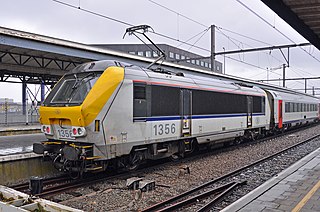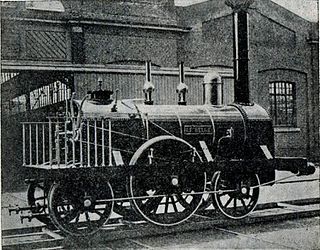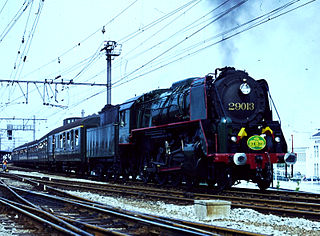The National Railway Company of Belgium is the national railway company of Belgium. The company formally styles itself using the Dutch and French abbreviations NMBS/SNCB. The corporate logo designed in 1936 by Henry van de Velde consists of the linguistically neutral letter B in a horizontal oval.

The Caledonian Railway 812 and 652 Classes were 0-6-0 steam tender locomotives designed by John F. McIntosh for the Caledonian Railway and introduced in 1899. They had the same boiler type as the 721 “Dunalastair” Class 4-4-0s. They were nicknamed "Jumbos" and they could reach speeds of up to 55 mph.

The Class 13 are a type of mixed use 200 km/h multivoltage electric locomotive of type Tractis designed by Alstom in the late 1990s for the Belgian and Luxembourgish railways.

La Brugeoise et Nivelles SA, later BN Constructions Ferroviaires et Métalliques, was a Belgian manufacturer of railway locomotives and other rolling stock; it was formed by a merger of two companies: La Brugeoise et Nicaise et Delcuve and Les Ateliers Métallurgiques de Nivelles.

The SNCB/NMBS HLE 18 are a series of four axle Bo′Bo′ multivoltage electric Siemens EuroSprinter locomotives ordered in two batches of sixty in 2006 and 2008.

Lineas the largest private rail freight operator in Europe with headquarters in Belgium and sites in France, Germany, Italy, the Netherlands and Spain. The Federal Holding and Investment Company holds 10% of the shares. Private equity group Argos Wityu and the management of Lineas together hold the remaining 90%.

Belgium was heavily involved in the early development of railway transport. Belgium was the second country in Europe, after Great Britain, to open a railway and produce locomotives. The first line, between the cities of Brussels and Mechelen opened in 1835. Belgium was the first state in Europe to create a national railway network and the first to possess a nationalised railway system. The network expanded fast as Belgium industrialised, and by the early 20th century was increasingly under state-control. The nationalised railways, under the umbrella organisation National Railway Company of Belgium (NMBS/SNCB), retained their monopoly until liberalisation in the 2000s.

The Caledonian Railway 721 Class was a class of 4-4-0 steam locomotives designed by John F. McIntosh for the Caledonian Railway (CR) and introduced in 1896. All survived to be absorbed by the London, Midland and Scottish Railway (LMS) in 1923 and a few survived into British Railways (BR) ownership in 1948.

The NMBS/SNCB Type 12 was a class of 4-4-2 steam locomotives built in 1938–1939 for the fast lightweight Ostend boat trains operated by the National Railway Company of Belgium.

The NMBS/SNCB Type 1 was a class of 4-6-2 steam locomotives built in 1935 and 1938 for working heavy express passenger trains operated by the National Railway Company of Belgium (NMBS/SNCB).
The Belgian State Railways was the original state-owned railway of Belgium. Established by an organic law of 1 May 1834, it began construction of its first line, between Brussels and Mechelen on 1 June 1834. This line, which was opened on 5 May 1835, was also the first steam-powered public railway in continental Europe.

The NMBS/SNCB Type 29 was a class of 2-8-0 steam locomotives built between 1945 and 1946. The class was ordered and used to help revive the operations of the National Railway Company of Belgium (NMBS/SNCB) following World War II. The locomotives were assembled in Canada and the United States, and supplied to Belgium under the auspices of what later became known as the Marshall Plan.

The NMBS/SNCB Type 26 was a class of 2-10-0 steam locomotives built between 1945 and 1947. Originally commissioned as part of an order for 200 DRB Class 52 Kriegslokomotiven placed by the Deutsche Reichsbahn (DRG) with Belgian locomotive manufacturers in 1943, the 100 members of the Type 26 class were completed for the National Railway Company of Belgium (NMBS/SNCB) following the liberation of Belgium late in 1944.

The Belgian State Railways Type 10, later known as the NMBS/SNCB Type 10, was a class of 4-6-2 steam locomotives built between 1910 and 1914.

The Belgian State Railways Type 23, later known as the NMBS/SNCB Type 53, was a class of 0-8-0T steam locomotives built between 1904 and 1927.

Herbesthal railway station was the Prussian/German frontier station on the main railway from Germany into Belgium between 1843 and 1920. It opened to rail traffic on 15 October 1843, and was thereby the oldest railway station frontier crossing in the world. It lost its border status on 10 January 1920, however, as a result of changes mandated in the Treaty of Versailles, which left Herbesthal more than 10 km inside Belgium.

The China Railways KD7 type steam locomotive was a type of 2-8-0 mainline general purpose steam locomotive. KD7 locomotives were built in the United States and supplied to China by UNRRA as part of the post war rehabilitation effort in 1946. China received 160 locos while others of the same design went to Belgium as NMBS/SNCB Type 29.

The NMBS/SNCB Type 64 was a class of 4-6-0 steam locomotives built as Prussian P 8s for German railways, delivered as war reparations to Belgium at the end of World War I. 168 locomotives of this type were delivered to Belgium, working mostly on light passenger trains operated by the National Railway Company of Belgium (NMBS/SNCB). The final locomotives of this type were withdrawn in 1967, marking the end of steam service in the country.

The NMBS/SNCB Type 36 was a class of 2-10-0 Decapod steam locomotives built from 1909 to 1914 for heavy freight service in Belgium operated by the National Railway Company of Belgium.

















